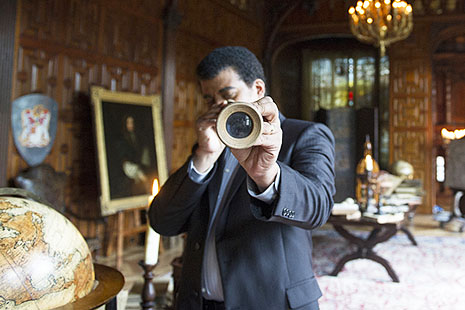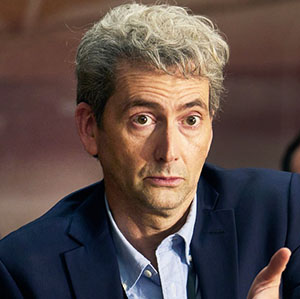Cosmos: A Spacetime Odyssey
Directed by Brannon Braga, Ann Druyan and Bill Pope | National Geographic Channel | $39.99
The American astronomer Carl Sagan’s television series Cosmos: A Personal Journey is one of the most celebrated works of popular science. Originally screened in 1980 on PBS in the United States and the ABC in Australia, it ranks alongside David Attenborough’s Life on Earth and the more recent Walking with Dinosaurs as an icon of factual broadcasting. Sagan presented a wide-ranging view of astronomy, covering science, history and a cosmic perspective, communicated in a poetic style and with an optimistic humanism that was appealing and memorable for a large audience. It has even been suggested that Cosmos inspired, almost on its own, a decade-long boom in science communication in the 1980s. No wonder, then, that so much attention has been given to the remake of this series as Cosmos: A Spacetime Odyssey, which has been screening on the National Geographic Channel in Australia and is out on DVD in July.
Sagan himself is no longer at the helm of this “spaceship of the imagination,” having died in 1996, but the new series is being steered by his co-writers Ann Druyan and Steven Soter. The presenter is astrophysicist Neil deGrasse Tyson, a former student of Sagan, who is director of the Hayden Planetarium in New York City and one of America’s most prominent science communicators. Druyan, Soter and Tyson worked together for seven years developing the pitch for this reboot, and in 2011, with the assistance of Family Guy director Seth MacFarlane, they received the go-ahead from Fox network.
The new Cosmos closely follows the format and philosophy of the original show, which is a testament to the strength of Sagan’s presentation. Both are thirteen-part series with episodes focusing on different aspects of astronomy, from the main features of our own solar system to the characteristics of distant galaxies. Some episodes are almost identical in theme, such as on the life cycles of stars, and both series present science beyond astronomy: in episodes on the development of life on Earth through evolution, for example. Most importantly, both series use the most effective tools of science popularisation. Stories of human endeavour and other emotional triggers, vivid analogies with political developments, and references to the philosophical implications of scientific knowledge are as much a part of the presentation as the finer points of astronomy. In particular, Sagan’s sense of connectedness with the universe – “we are all starstuff” – carries through both series.
This style of science popularisation has a long history. Exactly a hundred years before Sagan appeared on screen the astronomer Richard Proctor – the Sagan of his era – was lecturing to Australian audiences. Like Sagan and Tyson, Proctor was using some of the most advanced and realistic visualisations of his time. And, also like Sagan and Tyson, he was not afraid to engage in philosophical speculations or to couch his material in an emotionally appealing way. Indeed, many of the themes that Proctor developed – such as the possibility of life on other worlds, the potential effects of a comet hitting Earth, or the spiritual implications of the vastness of space – would still be part of the repertoire of astronomy popularisers a century later.
This is not to say that science communication hasn’t changed. In Sagan’s day, exploration by spacecraft had just begun; now, space telescopes routinely study distant galaxies. In Proctor’s time we didn’t even know other galaxies existed. A decade can be a long time in science, and a century an eternity. Yet old discoveries remain fresh for each new generation, as anyone who has looked at the ringed planet Saturn through a backyard telescope can attest. Science popularisations weave together stories of the old and the new: the details build and shift but the conversation is ongoing.
The media landscape has also changed dramatically since 1980. These changes have affected the production of Cosmos, and particularly its techniques of visualisation. While special effects were important in Sagan’s series, it is stating the obvious to say that technical advances since then have been extraordinary. Computer animation now allows sophisticated simulations of astronomical images presented in a photorealist manner, and effects like these are a baseline expectation for younger audiences brought up in a sophisticated visual media environment. It’s hard to imagine a series like Cosmos succeeding today without them.
Although the visualisations in the new Cosmos meet these high expectations – and some, like the cloud-tops of Jupiter, are alone worth watching the series for – the visual sequences are not entirely without flaws. Productions like this work best when form and content come together effortlessly, but unfortunately the directors of this series sometimes use recognisable but inaccurate visual devices to tell a story. This means that the first in line to nitpick about Cosmos were visualisation professionals, which is no surprise given not only that the American style of astronomical visualisation emphasises hyper-realistic data-driven simulations, but also that Tyson himself has been a somewhat pedantic critic of scientific errors in mainstream films. For some viewers, showing the asteroid belt as a crowded mass of rocks (whereas individual asteroids are separated by enormous gaps in reality) is like running fingernails down a blackboard.
These spectacular visualisations take time and money to produce. Even a show as well-resourced as this (the series budget has not been released, but no doubt it is somewhat higher than the original Cosmos’s $6 million) can’t deliver an hour a week of such content. So Cosmos largely consists of Tyson’s pieces to camera – sitting around a campfire or cycling through the Italian countryside – and the animated cartoons through which the histories of science are told. The former scenes work well – Tyson is a good presenter with enough (but not too much!) enthusiasm to draw audiences into his subject – but the latter aren’t as successful.
Visually, the cartoon style forms an odd juxtaposition with the sumptuous astronomical visualisation, but that isn’t the main issue. Although it’s unfair to the animation industry that “cartoon” is often used as a pejorative term, in Cosmos the unfortunate connotation is justified. The history of science presented in Cosmos is in large part shallow. Critics might suggest that this is one thing that hasn’t changed in thirty years; the original Cosmos contained its own dubious histories.
The show’s writers have defended their handling of some of this material, claiming that the script is accurate. Unfortunately, even when that’s the case (and sometimes they have just got it wrong) the show is often misleading. This is a common problem when science communicators reduce complex subjects to relatively few words. The words might be carefully crafted, but in the context of the program itself – which is how most of the audience will actually hear them – they can convey the wrong idea.
The discipline of science is highly attuned to the role of precedent and priority, and scientists are often keenly interested in the history of their subject. But the versions of scientific histories that they present for public consumption can sometimes be oversimplified, recast as instructive parables with success emphasised and failure always framed as a cautionary tale. Science educators are not the only ones who experience this impulse: the demands and conventions of broadcast production work against nuanced histories in any subject area. In order to make things easier for the viewer, stories are streamlined and themes strengthened; minor characters are discarded, and ambiguities stripped out. While these decisions are understandable, it’s reasonable to challenge them. Telling nuanced histories in science documentaries is difficult but worth the effort.
Historians of science may have the most reason to complain about Cosmos, but the loudest debate has involved viewers who are either for or against the series’ treatment of religion. Tyson – like Sagan before him – maintains a principled agnosticism, claiming that we cannot know that there is no supreme being. Both men describe how they have appreciated the wonders of astronomy as a religious experience that spiritual people need not fear. But this series – like the one before it – makes a clear argument that excessive religiosity stifles free enquiry.
Comparing how this element of the two series was received gives a very clear sense of how times have changed. Sagan was known to be a figure of the liberal left, and no doubt he attracted scorn from the American religious right at the time. But this didn’t significantly spill over into the public reception of the series. Thirty years on, the US debates over Intelligent Design, New Atheism and the increased partisan lines marking out evangelical Christianity have considerably increased sensitivity around the discussion of religion in society, and Tyson’s offerings have gone neither unnoticed nor unchallenged by the many defenders of religious values within the American commentariat. Tyson’s frequent use of Biblical phrasing or allusions – evolution is “the greatest story science ever told” and the Law of Relativity is a new “commandment” – and his playing on the scientist-as-god trope (at one point Tyson appears to pull apart and levitate the sedimentary layers of the Grand Canyon) must only add to their motivation. The Cosmos team may have intended such devices to be conciliatory, reflecting that shared sense of spirituality, and that may have been the case thirty years ago. Today they come across as something of a poke in the eye.
It is particularly interesting in this light to consider the decision to pitch the show to Fox, and the support given to the show by the network. While Fox’s overall primetime audience is light years away from the stridently partisan Fox News demographic, nonetheless the show is, as Fox executive Kevin Reilly observed, “on the periphery of our brand.” Its ratings, while good for a science documentary, have slipped disappointingly from the initial level of interest, indicating that the show failed to gain traction with these audiences. (For those of the Fox News audience who did stick around for Cosmos, I’m sure the episode dealing with scientific support for environmental regulation went down a treat.)
In many ways, Cosmos is best-practice science communication, and where it is not, it’s relatively easy to imagine how it could be made better. But to improve the series in this latter regard – to shift the relationship between the show and its audience – we need to reconsider the motivations behind science communication. As soon as a show looks like it is trying to win over opponents, to persuade doubters, to teach the masses, it is in trouble. This may seem paradoxical – surely the whole point of factual programming is to educate? The problem is that, much like the monkey trapped while reaching for a banana, the direct approach is not always the best.
If there is one thing that unites the science communication community it is that they know what they don’t like. And what they don’t like is the “deficit” model, the idea that the lay public lacks knowledge about science and it is the task of science communicators to provide this knowledge. Science communication is generally successful to the extent that it doesn’t remind people of a classroom, and this means that approaches based primarily on isolated facts are unlikely to be successful. Virtually every article about science communication over the past decade has contained the obligatory criticism of this model. So if everyone agrees this model is wrong, why do we need to keep talking about it?
It’s because this model is still the default position for many people – witness how discussions about the public understanding of science tend to be dominated by tests of the public’s recollection of various scientific facts. Communicators can fall into this trap even when they are aware of the risk. Tyson has stated in interviews that he doesn’t want to teach textbook science, because that’s not what people remember. Yet Cosmos has too many “textbook” moments trying to bring its audience up to speed on various technical details. And the more time spent telling us these details, the less time there is for stories about how we know, or why we care – hence the shortcuts made in the segments dealing with the histories of these ideas.
Because this problem is so widespread it may not seem to make much of a difference to the end result. Cosmos is still a great program. But if we want to improve the quality of the entire genre we need to consider the alternative models for understanding science communication. So what are they? Unsurprisingly, the research here is much less clearcut. Understanding that there are continuities of practice between scientists trying to convince each other in journals and presenters trying to convince audiences on television, another model for science communication sees it as a dialogue between scientists and communities, a negotiation between interested parties. But while these continuities exist, this picture doesn’t adequately capture experiences like Cosmos. Contemporary practitioners often speak about their role as one of inspiring: not as concerned about how many answers are recalled in post-evaluation testing as they are about how many new questions are prompted. Engaging new communities is crucial and outreach to non-traditional, less engaged audiences is prioritised.
Again, while this is a powerful part of the picture, it is only part. Much of science communication’s strongest interactions are with highly engaged audiences and it seems perverse to value least the interactions that are among the strongest. I would suggest that science communication is best viewed as a form of cultural support: building new relationships is important but so is strengthening those that already exist. Facts are important, but it is the themes and dreams that are built from them that will be significant for audiences.
There is one final reason why an excessive focus on detailed learning outcomes is detrimental to productions like Cosmos. The media environment has entirely changed as a result of the world wide web. Science communication podcasting or video offerings on YouTube are substantial – for example The Naked Scientists podcasts, Vi Hart’s mathematics videos, the Facebook (and beyond) phenomenon that is I Fucking Love Science and, of course, the ubiquitous Ted-Ed talks. The short, focused, on-demand and repeatable nature of these offerings makes them much more suitable for explaining detailed concepts. Large, setpiece television productions like Cosmos need to differentiate themselves, and they can do this most effectively by focusing attention upwards and outwards rather than inwards. Thirty years on, people still remember Sagan describing the thrill of a universe with billions and billions of stars: the techniques needed to measure them didn’t prove quite so memorable.
At this point, television productions still lay down markers in the history of popular culture in a way that the on-demand internet doesn’t, and can thus shape the ongoing cultural dialogue around astronomy, science and society. Cosmos: A Spacetime Odyssey is an important chapter in this dialogue, visually satisfying and ultimately worthwhile but not so well done that it will be the final chapter. It leaves us to anticipate meeting some protégé of Tyson’s as she walks along the Californian coastline in a few decades’ time. •




